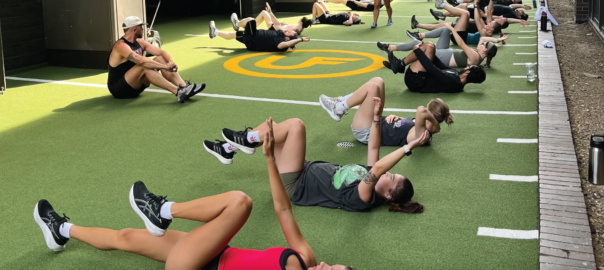Hi UF Community!
We all live different lives outside of our jobs, but it is important to establish and build a strong team in order to succeed in your workplace setting. I wanted to take a few minutes to shoutout and say thank you to every single one of our hard-working team members who are here at Union Fitness weekly.
Allyssa – She has been a hard worker since the start. She immediately took on clients and hopped on the sub list for our classes and the front desk and has never stopped working hard. She is also doing all this while in Physical Therapy school, which makes it even more impressive.
CJ – The wizard! He does it all here, whether it’s training almost all our University athletic teams, or several of his own clients, all while doing his management duties. He taught me all that I know when it comes to coaching group classes, and I’m forever thankful for that and for all he does to help keep UF in the best shape possible.
Curtis – This guy is truly one of the greatest humans out there. Fun fact: He is the one who hired me on as a part-time contractor back in 2020. He always goes above and beyond for his clients and for UF. He still puts in his full 100% effort even while having a baby at home, which I sincerely respect and admire. I am happy to call him a very good friend of mine.
Dahveed– I love the way he truly connects with both his clients and his athletes. He has a special way of interacting with them and making them feel like they are the most important people in the room. The amount of respect I have seen him gain from both his clients and athletes (and coaches, too) is highly commendable.
Adeel – He has been a stellar addition to the UF Team. He never hesitates to step up when it’s needed and is a super friendly face for when anyone and everyone comes into the gym. We are glad to have you on the team!
Eric – This guy showed up wearing an F45 hat, and we haven’t stopped messing with him about it. He has a great personality and has been able to fit himself right in with the UF crew. He’s already been crushing it with his own personal training clients and with subbing in for all our classes.
Ethan – He is one of the best trainers I have had the pleasure of working with. I have the utmost respect for him and for how hard of a worker he is. Ethan also brightens up the room with his jokes and humor, which we all appreciate. He started a new trend called “Opera music Fridays,” which helps keep the good vibes rolling in the Strength Lab on Friday afternoons.
Grayson – He is another one of our trainers who always puts a smile on everyone’s faces. He’s fun to mess with but will give you some attitude right back. You always need those people to help keep the environment light and fun, and Grayson is that person.
Hannah – She is one of the newest hires here at UF, but she has also shown herself to be one of the hardest workers in the room. From the start, she was ready to take on some of her own classes and clients. Hannah teaches Powerful every Monday at 6pm and Cardio Lab every Saturday at 9:30am. If you are looking for a perfectly fun and upbeat class, Hannah is your girl!
Hanson – He started as an intern last semester and has proven to be quite the “sponge” for information. He is always looking to learn and ask questions, which keeps him knowledgeable and ready to tackle the 6am Powerful class on Tuesday mornings. If you’re a morning person and are looking for a fun laugh while getting a great lift in, grab a coffee and check out his class!
Jared – This dude is one of the smartest and strongest guys out there. He has been keeping the gym running by opening on M/W/F at 5am for several years now, and even teaches our Powerful classes at 6am on those mornings as well. He has also built his own Physical Therapy business (Function Reforged) and runs it right here out of Union Fitness. If you’re injured or even just looking to get your form right, he is your guy!
Jen – She has been on the Front Desk team for quite some time now and has recently been promoted to be our Front Desk Supervisor! Jen has always crushed it when it comes to customer service and teamwork, and it really shows. She’s a friendly first face when you first walk into the gym and a great person to talk with about anything. We love having her on the team!
Justin – Justin started working here last year as one of our Front Desk employees, and he has been a consistent gym member since way before then. He is always willing to help the team, and help the gym grow in any way that it can! We love seeing him train and get strong in the Strength Lab every week as well.
Katie – Katie is always a super friendly and smiling face to see in the very dark hours of the morning. I don’t think I have ever seen her in a bad mood! She teaches Cardio Lab every Friday at 7am, so if you’re looking to get your butt kicked and start your weekend off right come and join her!
Kyle – This kid is one of the smartest dudes I know. You could ask him any question about training, and he will most likely know the answer. On top of working here, he also works at Pitt with some of their athletic teams. He always works hard, and it definitely shows.
Lauren – If you haven’t checked out a yoga class here at UF yet, you’re missing out! Lauren’s classes on Wednesday’s at 6pm and Sunday’s at 10:30am are always bumpin and she is awesome at what she does. She really cares about everyone that walks through the door and it shows.
Mary – Mary came here while she was still in school and immediately picked up coaching our university teams and cardio lab classes. She has been working hard since she first started and has not stopped. We appreciate all of her help!
Nick – Nick is another one of the newest hires here at UF and is one of the friendliest people I have ever met. He has been a great addition to our Front Desk team and has been willing to work hard ever since he started a few weeks ago. He is always willing to learn and wants to be sure he gets the job done right.
Rachael – Rachael is one of the most thorough coaches I have ever met. I can honestly say she is one of the best. The way that she truly cares about all our members and cares about the growth of the gym is so much appreciated by all of us on the management team. She is one of the OG coaches who has been here since close to the opening of UF, so the fact she is still here is awesome.
Roman – Roman may be quiet, but he is one of the nicest and friendliest employees we have. He has also been a long-time member here at Union, so it’s pretty cool to have him on the other side with us!
Sara – Sara is a serious OG. She’s been here since the beginning of UF’s time! She holds down the desk on the weekends and is a consistent devoted class member. We love having our employees take our classes!
Steph– Speaking of OG’s, Steph is also a serious OG. Her classes are one of the most popular ones here, only because everyone knows and loves her! Steph is always smiling and will always be sure to kick your butt!
Ted – Not many people are willing to be awake before 5am, let alone come to open a gym at 5am. Ted has been great for the past few months he has been here. He’s been coming here for the past few years as a Chatham Lacrosse athlete, so his working here now is awesome.
Vicki – Vicki came on board because her and Ted are coworkers at their other job, and both were members here. Another long-time member converted into a staff member. She is another quiet one, but super friendly. 😊
Zain – I like to think of Zain as my little brother (not just because he reminds me of my actual 9-year-old brother), but because we treat each other like siblings. I love how he is always in a positive mood and is always making UF a better place. I have really enjoyed seeing him grow here at UF from back when he was just lifting here, to being an intern, to now being the Head Personal Trainer.
Zoey – Zoey is from the same hometown as me, so that means we automatically have a cool connection. She’s also a Pitt grad, which we also have in common! She has been a great addition to the team, and I look forward to seeing her grow here at UF.









